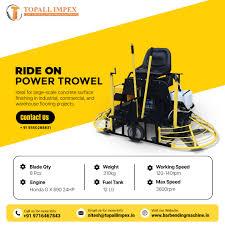Choosing the Right Power Trowel Blade: Float vs Finish Blades Explained

In the world of concrete finishing, achieving a smooth, durable surface requires the right tools—and among them, the power trowel stands out as a game-changer. But owning a power trowel isn’t enough. One of the most critical decisions you’ll make is choosing the right type of blade for the job. The two primary blade types are float blades and finish blades, each designed for a specific stage of the concrete finishing process.
If you're unsure about which blade to use, when to use it, and how it affects your final surface quality, you're in the right place. This blog breaks down the differences, applications, and key factors to consider when selecting between float and finish blades—with expert input from top power trowel manufacturers and suppliers.
What is a Power Trowel and Why Blade Choice Matters
A power trowel (also called a power float) is a construction machine used for finishing concrete floors. It smooths, compacts, and levels freshly poured concrete, creating a dense and polished surface. The effectiveness of a power trowel largely depends on the type of blade attached.
Using the wrong blade at the wrong time can result in uneven surfaces, reduced durability, or even damage to the concrete slab. That’s why understanding float blades and finish blades is essential for construction professionals and contractors alike.
Float Blades: For Initial Concrete Conditioning
What are Float Blades?
Float blades are wide, flat blades designed to be used in the early stages of concrete finishing. These blades are typically made of thicker steel and are either slightly curved or flat, depending on the brand and model.
Key Features of Float Blades:
-
Wide surface area for better floatation
-
Minimal angle of attack to avoid digging into wet concrete
-
Usually used with a pan float or directly attached to the trowel arms
When to Use Float Blades
Float blades are ideal when the concrete is still soft and moisture-rich. They are used to:
-
Break down high spots
-
Push down aggregate
-
Begin the leveling process
-
Prepare the slab for the finishing phase
Using float blades too late (on drier concrete) can lead to reduced blade effectiveness and uneven surfaces.
Finish Blades: For a Smooth, Hardened Surface
What are Finish Blades?
Finish blades are narrower and sharper than float blades. They’re made to produce a hard, glossy, smooth surface during the final stages of concrete finishing.
Key Features of Finish Blades:
-
Narrower profile for more concentrated pressure
-
Designed for polishing and hardening
-
Typically set at a higher angle of attack than float blades
-
Attached after float blades have completed initial leveling
When to Use Finish Blades
Finish blades should be used only after the concrete has partially cured and hardened enough to withstand more pressure. Their purpose includes:
-
Creating a dense surface layer
-
Smoothing out imperfections
-
Providing a polished finish
Applying finish blades too early can gouge or damage the slab, while using them too late may lead to excessive surface burnishing or dusting.
Float vs Finish Blades: A Quick Comparison
| Feature | Float Blades | Finish Blades |
|---|---|---|
| Used When | Concrete is fresh and soft | Concrete is semi-cured and firm |
| Blade Shape | Wide and flat | Narrower and angled |
| Purpose | Initial leveling and compaction | Final smoothing and polishing |
| Surface Contact | High surface contact area | More concentrated surface pressure |
| Typical Use | Early troweling | Final passes |
| Risk of Damage | Low (if used early) | High (if used too early) |
Tips for Choosing the Right Blade
Whether you're a contractor or project manager, here are a few practical tips to help you choose between float and finish blades effectively:
1. Understand Your Timing
-
Use float blades immediately after bleed water evaporates.
-
Switch to finish blades when the slab holds firm under pressure without sticking.
2. Know Your Trowel Type
-
Walk-behind trowels often require more frequent blade changes due to size.
-
Ride-on trowels allow quicker transitions between float and finish phases, often with combination blades.
3. Consider Combination Blades (Optional)
Some blades serve as a middle ground between float and finish types. While not as effective as dedicated float or finish blades, combo blades are useful in small or medium projects with time constraints.
4. Consult with Experts
Reputable Power Trowel Manufacturers and Power Trowel Suppliers often provide recommendations based on:
-
The machine model
-
Project type (industrial, commercial, residential)
-
Environmental conditions (temperature, humidity, etc.)
Where to Get Quality Power Trowel Blades
The performance of your blades depends heavily on quality manufacturing and reliable supply. When purchasing:
-
Choose from trusted Power Trowel Manufacturers who meet international quality standards.
-
Partner with reliable Power Trowel Suppliers who offer a variety of blade options and after-sales support.
-
Verify the compatibility of the blade with your machine brand and model.
Conclusion
The right blade can make or break your concrete finishing job. Float blades are best for early-stage leveling and preparing the surface, while finish blades deliver the final polish and strength your floor needs.
Always consider your timing, project requirements, and machine type when selecting between float and finish blades. And remember—partnering with top-tier Power Trowel Manufacturers and Power Trowel Suppliers ensures you're not just working hard, but smart.
- Vibnix Blog
- Politics
- News
- Liberia News
- Entertainment
- Technology
- Formazione
- Art
- Causes
- Crafts
- Dance
- Drinks
- Film
- Fitness
- Food
- Giochi
- Gardening
- Health
- Home
- Literature
- Music
- Networking
- Altre informazioni
- Party
- Religion
- Shopping
- Sports
- Theater
- Wellness



